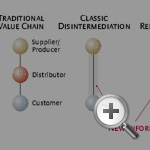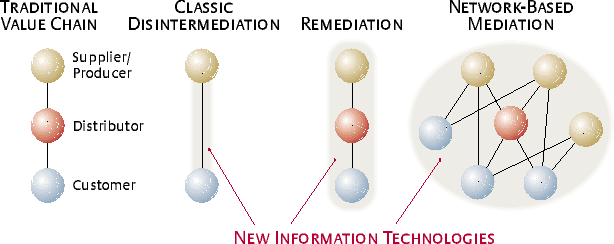The Digital Transformation of Traditional Business
Topics
During the 1990s, companies had vast amounts of funding for new information technologies, or NIT.1 They invested millions of dollars on Web sites, sophisticated software packages, teleconferencing equipment, broadband networks, mobile communications and other digital technologies. Such investments helped them to keep abreast of competitors that were making similar expenditures. Today, many companies are strapped for resources, and they need to be extremely selective about the technologies they fund, deploying NIT in ways that are the most relevant to their businesses and strategic objectives, including their sales and marketing efforts.
What kinds of companies and products can benefit most from the use of NIT? Books and airline tickets sell readily over the Internet whereas automobiles and high fashion clothing do not. Furthermore, what types of business transformations do such investments enable? A company might, for example, use NIT to cut away layers of middlemen, such as distributors, that separate it from its customers (called classic disintermediation). Or, instead of getting rid of middlemen, it might choose to embrace them (remediation). Or it might build strategic alliances and partnerships with new and existing players in a tangle of complex relationships (network-based mediation). (See “Three Mediation Strategies.”)
All three mediation strategies depend on various factors, such as a product’s customizability and information content. By fully understanding those drivers of NIT, companies can begin to predict the potential transformations of their industries, especially in terms of how products are marketed and sold. To that end, we have developed a systematic framework that identifies which drivers are important for the different approaches of classic disintermediation, remediation and network-based mediation. Using this tool, companies can determine both the optimum ways to transform their businesses and the NIT investments required to accomplish such changes.
References
1. We define NIT as information technologies commercialized in the 1990s as well as the more intensive and extensive applications of earlier information and communication technologies, or ICT.
2. See, for example, the “critical success factors,” which are quite different from our drivers, in J.F. Rockart, “The Changing Role of the Information Systems Executive: A Critical Success Factors Perspective,” MIT Sloan Management Review 24 (fall 1982): 3–13.
3. For some arguments for this driver, see Y. Bakos, “The Emerging Role of Electronic Marketplaces on the Internet,” Communications of the Association for Computing Machinery 41 (August 1998): 35–42.
4. See A. Slywotzky, “The Age of the Choiceboard,” Harvard Business Review 78 (January–February 2000): 40–41.
5. See S. Madnick and M. Siegel, “Seizing the Opportunity: Exploiting Web Aggregation,” MIS Quarterly Executive 1 (March 2002): 1–15; and Y. Bakos and E. Brynjolfsson, “Bundling and Competition on the Internet,” Marketing Science 19 (winter 2000): 63–82.
6. For similar examples, see S. Konicki, “A Page From Amazon’s Book,” Informationweek.com, Sept. 17, 2001, 105–107.
7. See P. Cartwright, “Only Converge: Networks and Connectivity in the Information Economy,” Business Strategy Review 13 (summer 2002): 59–64; and O. Shy, “The Economics of Network Industries” (Cambridge, U.K.: Cambridge University Press, 2001).
8. J.E. Frook, “Automotive Extranet Lights Fire Globally,” Internetweek, Apr. 20, 1998, special volume, 1.
9. See W. Ebeling and A. Snyder, “Targeting a Company’s Real Core Competencies,” Journal of Business Strategy 13 (November–December 1992): 26–32.
10. J. DiSabatino, “IBM and Air Canada Expand Relationship,” Computerworld, July 30, 2001, 61.
11. M. Songini, “Ford Gets Help With Global Supply Chain,” Computerworld, July 30, 2001, 12.
12. A similar argument is put forward by D. Rogers, “Who’s Afraid of Disintermediation?” Catalog Age 17 (August 2000): 12–13.
13. J. King, “Disintermediation/Reintermediation,” Computerworld, Dec. 13, 1999, 54–55.
14. For discussions related to remediation, see S. Vandermerwe, “The Electronic Go-Between Service Provider: A New Middle Role Taking Centre Stage,” European Management Journal 17, no. 6 (December 1999): 598–608; and P. Anderson and E. Anderson, “The New E-Commerce Intermediaries,” MIT Sloan Management Review 43 (summer 2002): 53–62.
15. See www.tesco.com.
16. For a discussion of network-based mediation, see N. Carr, “Hypermediation: Commerce as Clickstream,” Harvard Business Review 78 (January–February 2000): 46–47.
17. See also L. Downes, “The Strategy Machine” (New York: Harper Collins Publishers, 2002): 76–80, 93–96 and 127–128.
18. See “Business: Time To Rebuild,” The Economist, May 19, 2001, 55–56.
19. See “Wharton: The Chemdex Approach to B2B E-Commerce,” May 2000, http://www.ebizchronicle.com/wharton/07_chem.htm; and P. Samec, “Thinking Ahead on E-Marketplaces,” Computerworld, July 2, 2001, 24.



Comment (1)
JEAN-FRANCOIS GORE